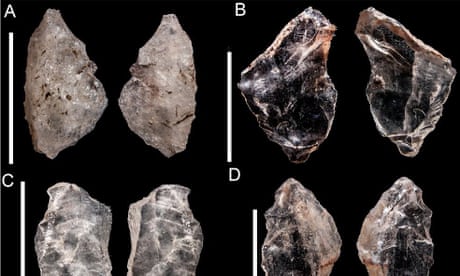- by foxnews
- 08 Apr 2025
65,000 year-old ‘Swiss Army knife’ proves ancient humans shared knowledge, research says
65,000 year-old ‘Swiss Army knife’ proves ancient humans shared knowledge, research says
- by theguardian
- 10 Jun 2022
- in news

A 65,000-year-old tool - a kind of ancient Swiss Army knife - found across southern Africa has provided scientists with proof that the ancestors of modern homo sapiens were communicating with each other.
In a world first, a team of international scientists have found early humans across the continent made the stone tool in exactly the same shape, using the same template, showing that they shared knowledge with each other.
The artefacts, also known as the "stone Swiss Army knife" of prehistory, were made to a similar template across great distances, the study - published in Scientific Reports - reveals.
These tools were produced in enormous numbers across southern Africa roughly 60-65,000 years ago.
Because the people across southern Africa all chose to make the tools look the same, it indicates they must have been socially connected, said Amy Way, the project's lead archeologist, from the Australian Museum and the University of Sydney.
"The really exciting thing about this find is that it gives us evidence that there was long-distance social connection between people, just before the big migration out of Africa, which involved all of our ancestors," she said.
The question that really baffles archeologists is why the big exit from Africa, which took place 60-70,000 years ago and involved the ancestors of everyone who lives outside Africa today, was so successful when previous excursions out of the continent were not.
"The main theory is that social networks were stronger at this time. This analysis shows for the first time that these social connections were in place in southern Africa just before the big exodus," Way said.
The tool was used for numerous things, including cutting, drilling, and skinning.
Previous research has shown that in southern Africa, the artefacts were used as barbs in hunting technology and in Australia, in addition to forming armatures in spears, they were also used for working bone and hide and drilling and shaping wooden objects.
In Africa they have now been found 1,200 kilometres apart, Way said.
"One hundred kilometres takes five days to walk, so it's probably a whole network of groups that are mostly in contact with the neighbouring group," she said.
Way said another fascinating fact about this particular tool - the backed artefact - is that it was made independently by many different groups of people across the world, including here in Australia.
"I compared some of the Australian shapes from 5,000 years ago with the African shapes [of] 65,000 years ago - as they can't possibly be related - to show the southern African tools all cluster within a much larger range of possible shapes," Way said.
"It is this abundance of the backed artefacts which speaks to their success in this region at this time, and also highlights that for modern humans those social connections did indeed exist just before they left Africa."
- by foxnews
- descember 09, 2016
Ancient settlement reveals remains of 1,800-year-old dog, baffling experts: 'Preserved quite well'
Archaeologists have recently unearthed the remarkably well-preserved remains of a dog from ancient Rome, shedding light on the widespread practice of ritual sacrifice in antiquity.
read more


